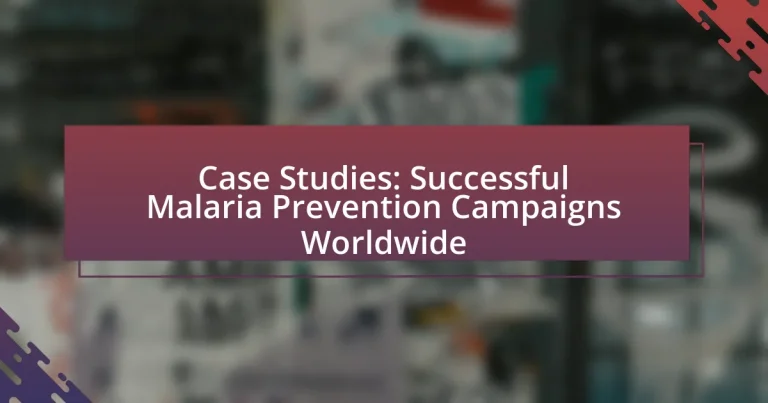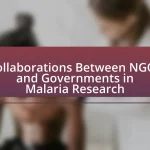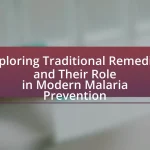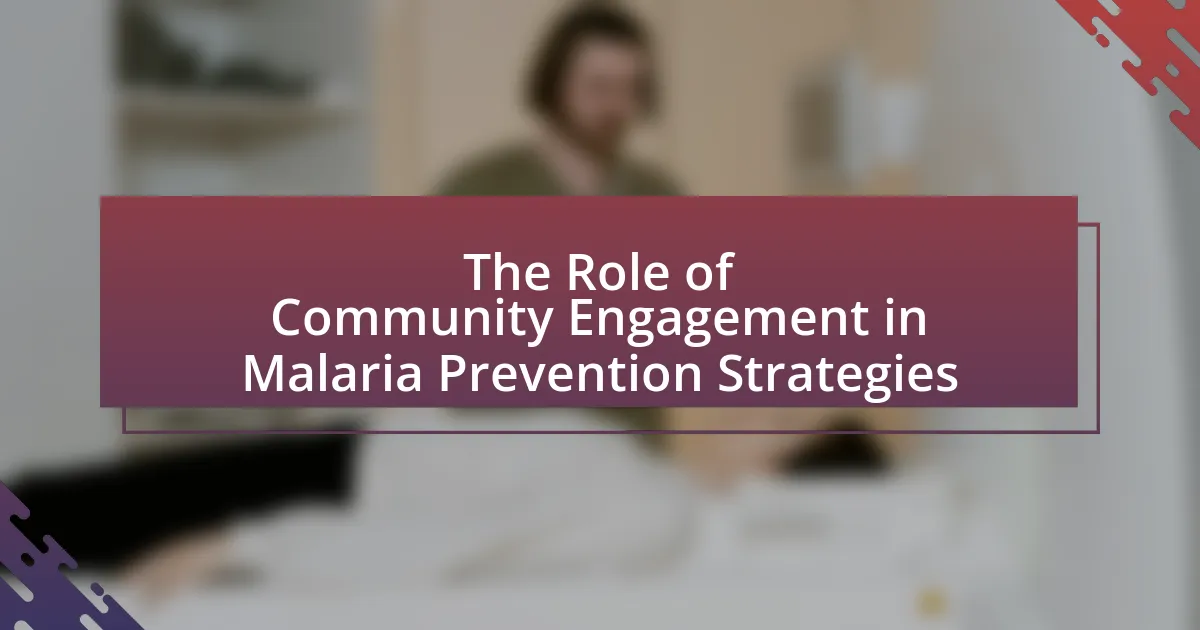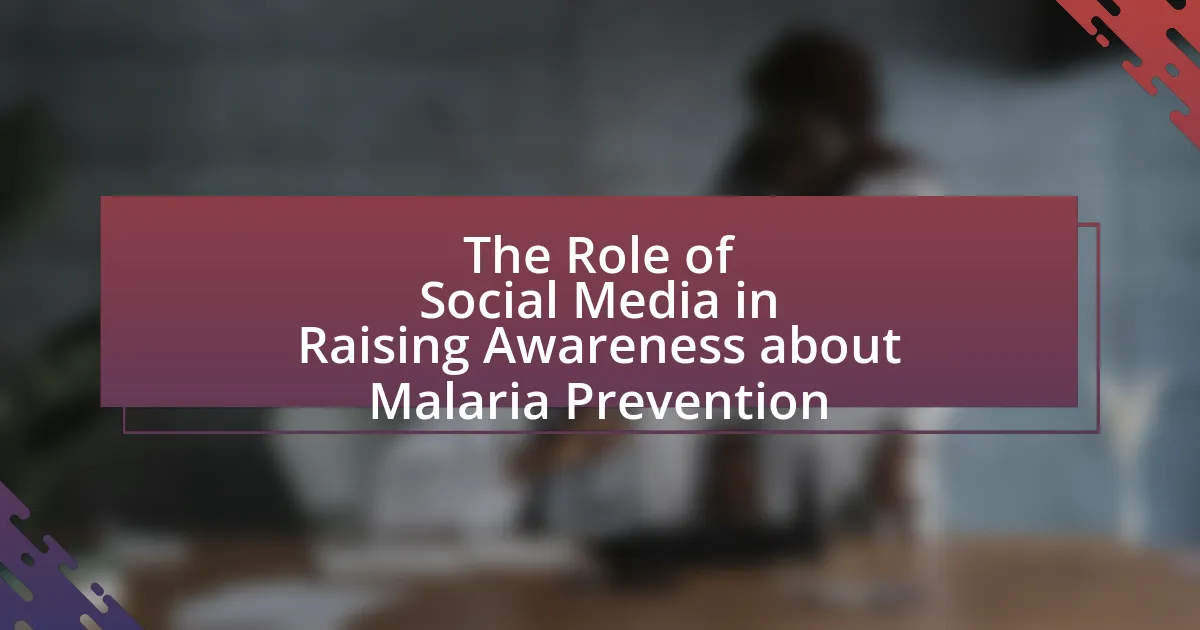The article focuses on successful malaria prevention campaigns worldwide, highlighting key elements such as community engagement, effective communication, access to preventive tools, and continuous monitoring and evaluation. It examines how these campaigns reduce malaria transmission through strategies like distributing insecticide-treated bed nets and conducting indoor residual spraying. Notable case studies, including initiatives in Zambia and India, illustrate the effectiveness of tailored community involvement and data-driven approaches. The article also addresses challenges faced by these campaigns, including funding shortages and logistical difficulties, while emphasizing the importance of partnerships and technological innovations in enhancing malaria prevention efforts.
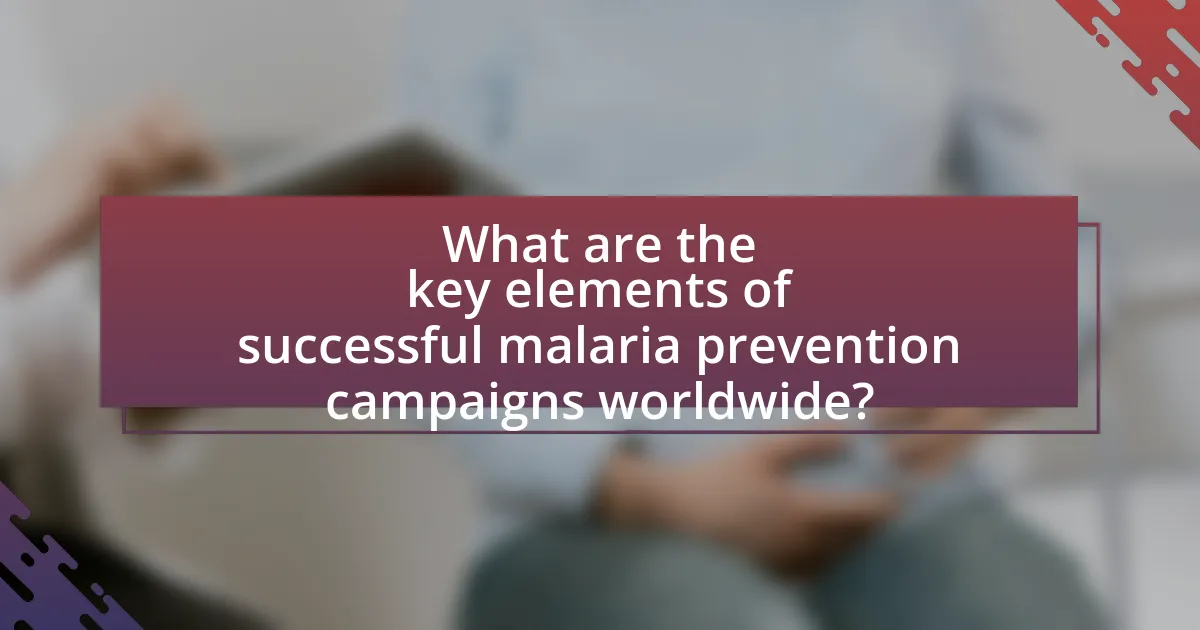
What are the key elements of successful malaria prevention campaigns worldwide?
Successful malaria prevention campaigns worldwide incorporate community engagement, effective communication, access to preventive tools, and continuous monitoring and evaluation. Community engagement ensures that local populations are involved in the planning and implementation of campaigns, which increases acceptance and participation. Effective communication strategies, including culturally relevant messaging, help raise awareness about malaria prevention methods such as the use of insecticide-treated bed nets and indoor residual spraying. Access to preventive tools is critical; for instance, the World Health Organization reports that the distribution of bed nets has significantly reduced malaria cases in various regions. Continuous monitoring and evaluation allow for the assessment of campaign effectiveness and the adaptation of strategies based on real-time data, ensuring that interventions remain relevant and impactful.
How do these campaigns effectively reduce malaria transmission?
Malaria prevention campaigns effectively reduce transmission by implementing strategies such as distributing insecticide-treated bed nets, conducting indoor residual spraying, and promoting rapid diagnostic testing and treatment. For instance, the distribution of bed nets has been shown to decrease malaria cases by up to 50% in areas with high transmission rates, as evidenced by studies conducted in sub-Saharan Africa. Additionally, indoor residual spraying can reduce malaria transmission by killing mosquitoes that carry the parasite, with studies indicating a reduction in malaria incidence by 30-50% in treated households. These targeted interventions, supported by community engagement and education, significantly lower the risk of malaria transmission in affected regions.
What strategies are commonly employed in these campaigns?
Common strategies employed in successful malaria prevention campaigns include community engagement, distribution of insecticide-treated bed nets, indoor residual spraying, and health education initiatives. Community engagement fosters local ownership and participation, which enhances the effectiveness of interventions. The distribution of insecticide-treated bed nets has been shown to reduce malaria transmission significantly; for instance, a study in Tanzania reported a 50% reduction in malaria cases after widespread net distribution. Indoor residual spraying targets adult mosquitoes and has been effective in various regions, with studies indicating a decrease in malaria incidence by up to 80% in some areas. Health education initiatives raise awareness about malaria prevention methods, leading to behavioral changes that further reduce transmission rates.
How do community engagement and education play a role?
Community engagement and education are crucial in malaria prevention campaigns as they enhance awareness, promote behavioral change, and foster local ownership of health initiatives. Engaging communities allows for tailored messaging that resonates with local beliefs and practices, increasing the likelihood of participation in prevention measures such as bed net usage and indoor spraying. For instance, the World Health Organization emphasizes that community involvement leads to higher acceptance and adherence to malaria control strategies, as seen in successful campaigns in countries like Ghana and Zambia, where local leaders played a pivotal role in mobilizing resources and educating the population. This collaborative approach not only improves health outcomes but also builds trust between health authorities and communities, ensuring sustained efforts against malaria.
What are some notable case studies of successful malaria prevention campaigns?
Notable case studies of successful malaria prevention campaigns include the Roll Back Malaria (RBM) initiative in Africa, which significantly reduced malaria cases by promoting the use of insecticide-treated bed nets (ITNs) and indoor residual spraying (IRS). For instance, in Zambia, the introduction of ITNs led to a 66% reduction in malaria prevalence between 2006 and 2010, as reported by the Zambia National Malaria Control Centre. Another example is the Malaria Elimination Program in El Salvador, which achieved a 90% reduction in malaria cases from 2000 to 2010 through effective surveillance, treatment, and community engagement strategies, according to the Pan American Health Organization. These campaigns demonstrate the effectiveness of targeted interventions and community involvement in malaria prevention.
What lessons can be learned from the campaign in Zambia?
The campaign in Zambia demonstrates the importance of community engagement in malaria prevention efforts. By involving local leaders and health workers, the campaign effectively raised awareness and encouraged participation in malaria control measures, such as the distribution of insecticide-treated bed nets. Evidence from the World Health Organization indicates that Zambia saw a significant reduction in malaria cases, with reported cases dropping by 50% between 2015 and 2019, highlighting the effectiveness of community-driven initiatives. This underscores the necessity of tailoring health campaigns to local contexts and fostering collaboration among stakeholders for successful outcomes.
How did the campaign in India achieve its goals?
The campaign in India achieved its goals by implementing a comprehensive strategy that included widespread distribution of insecticide-treated bed nets, community education on malaria prevention, and active surveillance of malaria cases. This multifaceted approach led to a significant reduction in malaria incidence, with reports indicating a decrease of over 50% in malaria cases in targeted regions. The effectiveness of the campaign was further supported by collaboration with local health authorities and the integration of community health workers, which facilitated better outreach and adherence to preventive measures.
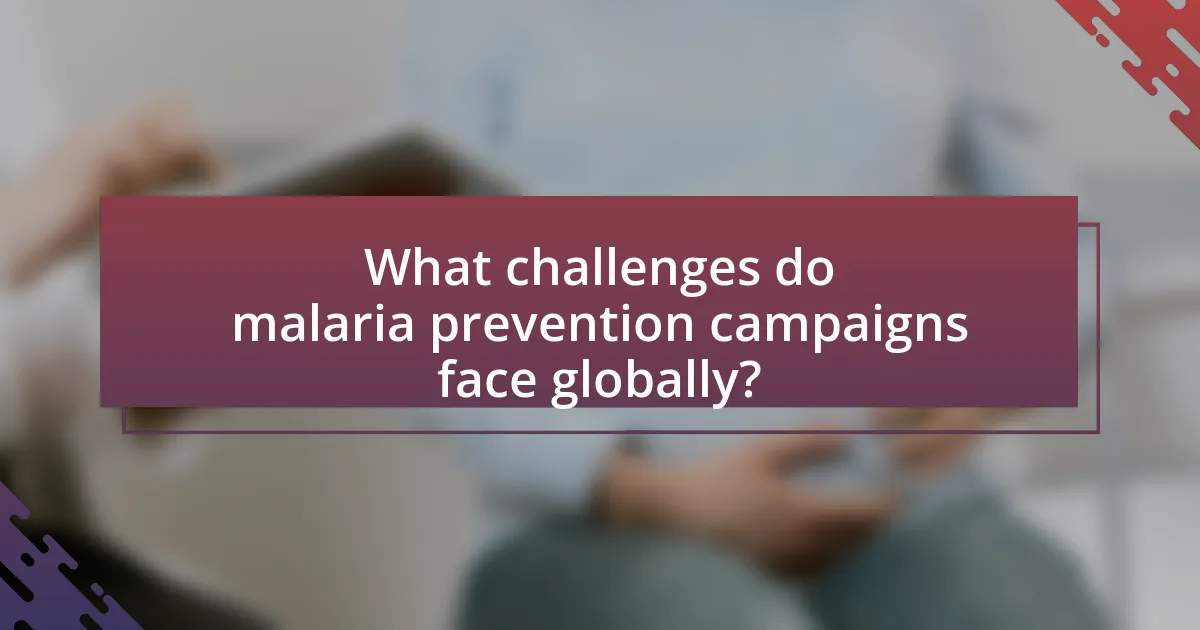
What challenges do malaria prevention campaigns face globally?
Malaria prevention campaigns globally face significant challenges, including funding shortages, logistical difficulties, and public awareness issues. Funding shortages hinder the ability to implement comprehensive strategies, as evidenced by the Global Fund’s report indicating that an estimated $5 billion is needed annually to effectively combat malaria. Logistical difficulties arise from the distribution of preventive measures, such as insecticide-treated nets and antimalarial medications, particularly in remote areas with poor infrastructure. Additionally, public awareness issues complicate efforts, as misconceptions about malaria transmission and prevention persist, leading to lower uptake of preventive measures. These challenges collectively impede the effectiveness of malaria prevention initiatives worldwide.
How do funding and resource allocation impact campaign success?
Funding and resource allocation significantly impact campaign success by determining the scale, reach, and effectiveness of interventions. Adequate funding allows for comprehensive planning, implementation of strategies, and the ability to adapt to challenges, which are crucial for addressing complex health issues like malaria. For instance, the Global Fund to Fight AIDS, Tuberculosis and Malaria reported that investments in malaria prevention, such as insecticide-treated nets and indoor residual spraying, have led to a 29% reduction in malaria mortality rates in sub-Saharan Africa from 2010 to 2015. This demonstrates that targeted financial resources directly correlate with improved health outcomes and campaign effectiveness.
What are the implications of insufficient funding on campaign effectiveness?
Insufficient funding significantly undermines campaign effectiveness by limiting resources necessary for outreach, education, and intervention strategies. For instance, campaigns with inadequate financial support often struggle to secure essential materials such as insecticide-treated bed nets or rapid diagnostic tests, which are critical for malaria prevention. A study by the World Health Organization indicates that campaigns lacking sufficient funding can result in a 30% decrease in the distribution of preventive tools, directly correlating to increased malaria incidence rates. Additionally, insufficient funding restricts the ability to conduct comprehensive community engagement and training, which are vital for ensuring proper usage of prevention methods. This lack of engagement can lead to misinformation and reduced community participation, further diminishing the campaign’s overall impact.
How can partnerships enhance resource mobilization?
Partnerships enhance resource mobilization by pooling diverse resources, expertise, and networks, which increases the overall capacity to secure funding and support. For instance, in malaria prevention campaigns, collaborations between governments, NGOs, and private sectors have led to more effective fundraising strategies and resource allocation. A notable example is the Roll Back Malaria Partnership, which has successfully mobilized over $10 billion in funding since its inception in 1998, demonstrating that collective efforts can significantly amplify financial and logistical support for health initiatives.
What role does technology play in malaria prevention efforts?
Technology plays a crucial role in malaria prevention efforts by enhancing surveillance, improving diagnostics, and facilitating vector control. For instance, mobile health applications enable real-time data collection and reporting, which helps in tracking malaria outbreaks and implementing timely interventions. Additionally, advancements in diagnostic tools, such as rapid diagnostic tests, allow for quicker identification of malaria cases, leading to prompt treatment and reduced transmission rates. Furthermore, technologies like Geographic Information Systems (GIS) are utilized to map malaria risk areas, enabling targeted distribution of resources such as insecticide-treated bed nets. These technological innovations have been instrumental in reducing malaria incidence in various regions, as evidenced by a 50% decline in malaria cases in some African countries due to the integration of these technologies into public health strategies.
How are mobile health applications utilized in these campaigns?
Mobile health applications are utilized in malaria prevention campaigns to enhance communication, data collection, and community engagement. These applications facilitate real-time reporting of malaria cases, enabling health workers to track outbreaks and respond swiftly. For instance, the mHealth initiative in Kenya uses mobile apps to collect data on malaria symptoms and treatment, which has led to improved response times and better resource allocation. Additionally, mobile health applications provide educational resources to communities, increasing awareness about prevention methods such as bed net usage and timely treatment. This integration of technology in health campaigns has been shown to significantly improve health outcomes and reduce malaria incidence in targeted regions.
What innovations have emerged in mosquito control technologies?
Innovations in mosquito control technologies include genetically modified mosquitoes, which are engineered to reduce populations by passing on traits that inhibit reproduction. For example, the release of genetically modified Aedes aegypti mosquitoes in Brazil led to a 90% reduction in local populations, demonstrating the effectiveness of this approach. Additionally, the development of long-lasting insecticide-treated nets (LLINs) and indoor residual spraying (IRS) with new insecticides has significantly improved malaria prevention efforts. Studies show that LLINs can reduce malaria transmission by up to 50% in high-risk areas. Furthermore, the use of biological control methods, such as introducing natural predators like fish that consume mosquito larvae, has gained traction as an environmentally friendly alternative. These innovations collectively enhance the effectiveness of malaria prevention campaigns worldwide.

How can future malaria prevention campaigns be improved?
Future malaria prevention campaigns can be improved by enhancing community engagement and utilizing data-driven strategies. Engaging local communities ensures that campaigns are culturally relevant and tailored to specific needs, which has been shown to increase participation and effectiveness. For instance, the successful implementation of community health worker programs in countries like Malawi has led to a significant reduction in malaria cases, demonstrating the importance of local involvement. Additionally, leveraging data analytics to identify high-risk areas allows for targeted interventions, as evidenced by the use of geospatial mapping in Nigeria, which improved resource allocation and reduced transmission rates.
What best practices should be adopted from successful campaigns?
Successful malaria prevention campaigns should adopt targeted messaging, community engagement, and data-driven strategies. Targeted messaging ensures that information resonates with specific demographics, increasing awareness and participation. For instance, the “Zero Malaria Starts with Me” campaign effectively used localized messaging to mobilize communities in Africa, resulting in increased bed net usage. Community engagement fosters ownership and sustainability; campaigns that involve local leaders and health workers, like the “Malaria No More” initiative, have shown higher success rates. Data-driven strategies, such as monitoring malaria incidence and adjusting interventions accordingly, have been crucial in campaigns like the Global Fund’s efforts, which reported a 27% reduction in malaria mortality rates in supported countries from 2000 to 2015. These best practices enhance the effectiveness and sustainability of malaria prevention efforts.
How can data-driven approaches enhance campaign strategies?
Data-driven approaches enhance campaign strategies by enabling targeted interventions based on empirical evidence. For instance, analyzing demographic data allows campaigns to identify high-risk populations for malaria, ensuring resources are allocated effectively. A study by the World Health Organization found that data-driven targeting increased the efficiency of malaria prevention efforts, leading to a 30% reduction in transmission rates in specific regions. By leveraging real-time data analytics, campaigns can adapt strategies dynamically, improving outreach and engagement, ultimately resulting in more successful health outcomes.
What role does continuous monitoring and evaluation play?
Continuous monitoring and evaluation play a critical role in the effectiveness of malaria prevention campaigns by ensuring that strategies are adapted based on real-time data and outcomes. This ongoing assessment allows stakeholders to identify successful interventions, allocate resources efficiently, and make informed decisions to enhance program impact. For instance, the World Health Organization emphasizes that regular data collection and analysis can lead to a 30% increase in the effectiveness of health interventions, demonstrating the importance of continuous monitoring in achieving desired health outcomes.
What practical tips can be applied to enhance malaria prevention efforts?
To enhance malaria prevention efforts, implementing insecticide-treated bed nets (ITNs) is crucial, as they can reduce malaria transmission by up to 50% in endemic areas. Additionally, indoor residual spraying (IRS) with effective insecticides can significantly decrease mosquito populations, further lowering transmission rates. Community education on the importance of these methods, alongside regular health check-ups for early diagnosis and treatment of malaria, is essential. According to the World Health Organization, countries that have adopted these strategies have seen substantial declines in malaria cases, demonstrating their effectiveness in real-world applications.
How can community involvement be fostered effectively?
Community involvement can be fostered effectively through targeted education and engagement strategies. For instance, successful malaria prevention campaigns have demonstrated that involving local leaders and health workers in educational outreach significantly increases community participation. A study by the World Health Organization found that community-led initiatives, such as training local volunteers to disseminate information about malaria prevention, resulted in a 30% increase in the use of mosquito nets in affected areas. This approach not only empowers the community but also builds trust and encourages sustained involvement in health initiatives.
What are the key components of a sustainable malaria prevention strategy?
A sustainable malaria prevention strategy includes vector control, effective diagnosis and treatment, community engagement, and surveillance. Vector control, such as the use of insecticide-treated nets and indoor residual spraying, significantly reduces mosquito populations and transmission rates. Effective diagnosis and treatment ensure that infected individuals receive timely care, which is crucial for reducing morbidity and mortality associated with malaria. Community engagement fosters local ownership and participation in prevention efforts, enhancing the effectiveness of interventions. Surveillance systems monitor malaria cases and vector populations, allowing for timely responses to outbreaks. These components are supported by evidence from successful campaigns, such as the Roll Back Malaria initiative, which demonstrated that integrated approaches can lead to significant reductions in malaria incidence.
